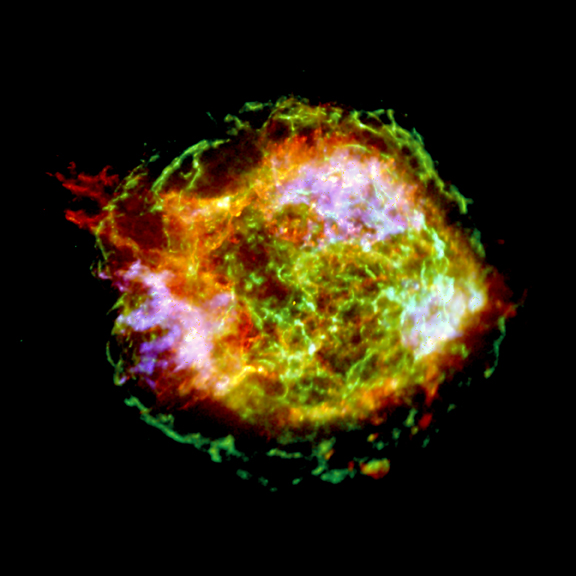http://en.wikipedia.org/wiki/Cassiopeia_A wrote:
<<Cassiopeia A (Cas A) is a supernova remnant in the constellation Cassiopeia and the brightest astronomical radio source in the sky. The supernova occurred approximately 11,000 light-years (3.4 kpc) away in the Milky Way. The expanding cloud of material left over from the supernova is now approximately 10 light-years (3.1 pc) across. Despite its radio brilliance, however, it is extremely faint optically, and is only visible on long-exposure photographs.
It is believed that first light from the stellar explosion reached Earth approximately 300 years ago but there are no historical records of any sightings of the progenitor supernova, probably due to interstellar dust absorbing optical wavelength radiation before it reached Earth (although it is possible that it was recorded as a sixth magnitude star 3 Cassiopeiae by John Flamsteed on August 16, 1680). Possible explanations lean toward the idea that the source star was unusually massive and had previously ejected much of its outer layers. These outer layers would have cloaked the star and reabsorbed much of the light released as the inner star collapsed.
Calculations working back from the currently observed expansion point to an explosion around 1667. Observations of the exploded star through the Hubble telescope have shown that, despite the original belief that the remnants were expanding in a uniform manner, there are 2 opposing jets of debris that are traveling at 32 million miles per hour. This speed is estimated to be 20 million miles per hour faster than the rest of the debris. When the view of the expanding star uses colors to differentiate materials of different chemical compositions, it shows that similar materials often remain gathered together in the remnants of the explosion.
Cas A is the strongest radio source in the sky beyond our solar system, and was among the first discrete sources to be found, in 1947. The optical component was first identified in 1950.
In 1979, Shklovsky predicted that Cas A had a black hole. In 1999, the Chandra X-Ray Observatory found a "hot point-like source" close to the center of the nebula that is quite likely the neutron star or black hole predicted but not previously found. Although Cas X-1 (or Cas XR-1), the apparent first X-ray source in the constellation Cassiopeia was not detected during the June 16, 1964, Aerobee sounding rocket flight, it was considered as a possible source. Cas X-1 is Cas A, a Type II SNR at RA 23h 18m Dec +58° 30′.
Recently, infrared echo of Cassiopeia A explosion was observed on nearby gas clouds using Spitzer Space Telescope. The recorded spectrum proved the supernova was of Type IIb, meaning it resulted from the internal collapse and violent explosion of a massive star, most probably a red supergiant with a helium core which had lost almost all of its hydrogen envelope. This was the first observation of the infrared echo of a supernova which explosion had not been directly observed which opens up the possibility of studying and reconstructing past astronomical events.>>



